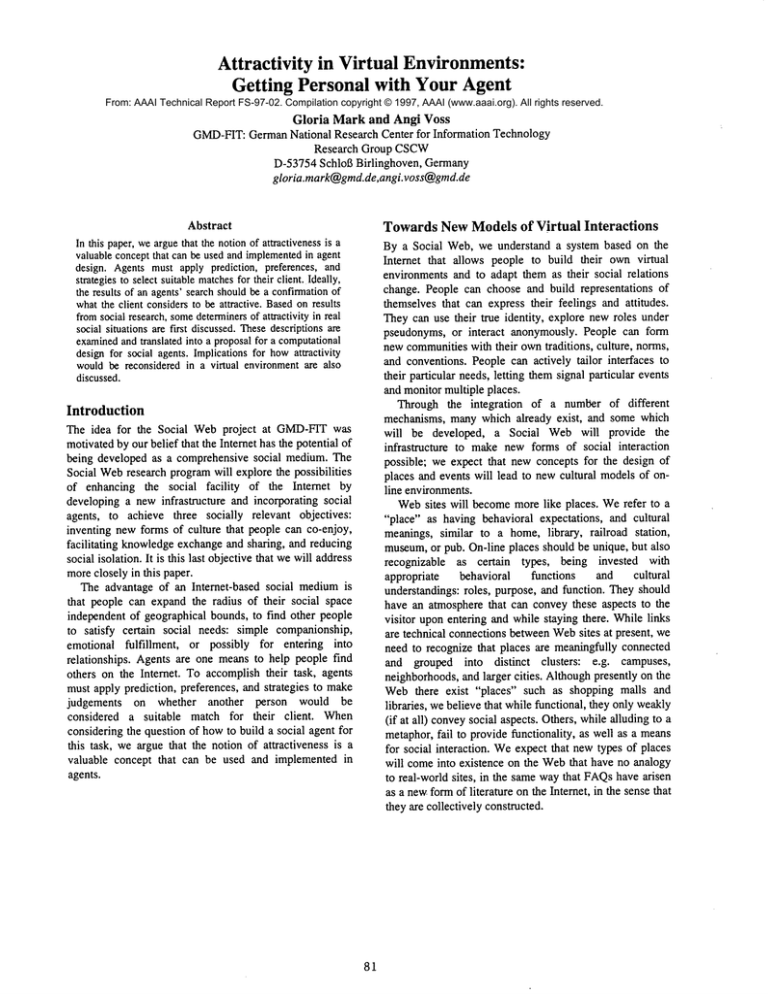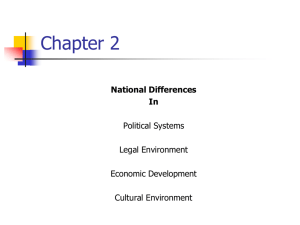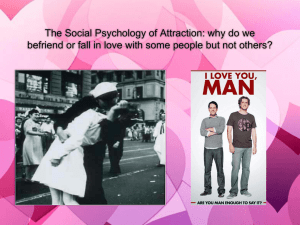
Attractivity in Virtual Environments:
Getting Personal with Your Agent
From: AAAI Technical Report FS-97-02. Compilation copyright © 1997, AAAI (www.aaai.org). All rights reserved.
Gloria Mark and Angi Voss
GMD-FIT:
GermanNational Research Center for Information Technology
Research Group CSCW
D-53754Schlog Birlinghoven, Germany
gloria.mark@gmd.de,angi, voss@gmd.de
Abstract
In this paper,wearguethat the notionof attractivenessis a
valuableconceptthat canbe usedand implemented
in agent
design. Agentsmust apply prediction, preferences, and
strategiesto selectsuitablematches
for their client. Ideally,
the results of an agents’searchshouldbe a confirmation
of
whatthe client considersto be attractive. Basedonresults
fromsocial research,somedeterminers
of attractivity in real
social situationsare fLrst discussed.Thesedescriptionsare
examined
andtranslated into a proposalfor a computational
designfor social agents. Implicationsfor howatwactivity
wouldbe reconsideredin a virtual environmentarc also
discussed.
Towards New Models of Virtual Interactions
By a Social Web, we understand a system based on the
Internet that allows people to build their ownvirtual
environmentsand to adapt themas their social relations
change. People can choose and build representations of
themselvesthat can express their feelings and attitudes.
Theycan use their true identity, explore newroles under
pseudonyms, or interact anonymously. People can form
newcommunitieswith their owntraditions, culture, norms,
and conventions. People can actively tailor interfaces to
their particular needs, letting themsignal particular events
and monitormultiple places.
Through the integration of a number of different
mechanisms,manywhich already exist, and some which
will be developed, a Social Webwill provide the
infrastructure to makenew forms of social interaction
possible; we expect that new concepts for the design of
places and events will lead to newcultural modelsof online environments.
Websites will becomemore like places. Werefer to a
"place" as having behavioral expectations, and cultural
meanings, similar to a home,library, railroad station,
museum,or pub. On-line places should be unique, but also
recognizable as certain types, being invested with
appropriate
behavioral functions and cultural
understandings: roles, purpose, and function. Theyshould
have an atmospherethat can conveythese aspects to the
visitor uponentering and while staying there. Whilelinks
are technical connectionsbetweenWebsites at present, we
need to recognize that places are meaningfullyconnected
and grouped into distinct clusters: e.g. campuses,
neighborhoods,and larger cities. Althoughpresently on the
Webthere exist "places" such as shopping malls and
libraries, webelieve that whilefunctional, they onlyweakly
(if at all) conveysocial aspects. Others,while alludingto
metaphor,fail to provide functionality, as well as a means
for social interaction. Weexpect that newtypes of places
will comeinto existence on the Webthat have no analogy
to real-world sites, in the samewaythat FAQshave arisen
as a newformof literature on the Internet, in the sense that
they are collectively constructed.
Introduction
The idea for the Social Webproject at GMD-FITwas
motivatedby our belief that the Intemethas the potential of
being developed as a comprehensivesocial medium.The
Social Webresearch programwill explore the possibilities
of enhancing the social facility of the Internet by
developing a newinfrastructure and incorporating social
agents, to achieve three socially relevant objectives:
inventing newforms of culture that people can co-enjoy,
facilitating knowledgeexchangeand sharing, and reducing
social isolation. It is this last objectivethat wewill address
moreclosely in this paper.
The advantage of an Internet-based social mediumis
that people can expandthe radius of their social space
independentof geographical bounds, to find other people
to satisfy certain social needs: simple companionship,
emotional fulfillment, or possibly for entering into
relationships. Agents are one meansto help people find
others on the Internet. To accomplishtheir task, agents
must apply prediction, preferences, and strategies to make
judgements on whether another person would be
considered a suitable match for their client. When
consideringthe questionof howto build a social agent for
this task, we argue that the notion of attractiveness is a
valuable concept that can be used and implemented in
agents.
81
Weexpect that people will develop new modelsof online places, events, and social processes, in whichthey can
have expectations of, and preferences for, what they can
experience. Suchmodelscan be a basis for initiating new
events and processes in an on-line environment.However,
we expect that people will also develop new models of
individuals in such a virtual environment.The question of
whowe choose to interact with in such an environment
takes on a newsignificance.
choosingwhoto initiate contact with, and if the other is
deemedattractive, deciding to continue further with
acquaintanceship.Acquaintanceship,can of course, further
develop into a relationship which some researchers
describein termsof further stages: build-up, consolidation,
deterioration, and ending(e.g. Levinger,1983).
Whyshouldwe considerattractiveness? In its role in the
early selection processof meetingpeople, attractivity plays
an importantrole in determiningwhichsocial relationships
will be pursued. Whenwe meet others, we attempt to
incorporate information about theminto our frameworkof
intentions, motives, and causal relations, all of whichare
used to composea modelof the other and can be used to
predict howthe other mayact (Johnson-Laird, 1983). One
of the values of attractiveness is that it reducescognitive
overload in evaluating and selecting others. Judging
anotheruponmeeting,using a criteria of attractiveness, has
decided advantages; it is not possible to systematically
evaluate each single characteristic of another, since it
wouldexceed the capacity of our working memory.Thus,
we can select information about another to process, which
enables us to reduce cognitive overhead. Applying
stereotypes is one exampleof howjudgmentsare madevia
category formation. A second value for attractiveness is
that the continual developmentof a social relationship
involves a high investment, and therefore attractivity is
important in f’mding the right candidate. Froma costbenefit viewpoint, a model of attractiveness becomesa
normative method to reduce risks of failure, and to
optimizesuccessin findingthe right people.
To answer how we can design agents to apply their
clients’ modelof attractivenessto others, it first leads us to
examineother questions. First, we begin by considering
whatconstitutes attractivity for people in real life social
situations. Wecan then think about what assumptions
about attractivity from real life we can apply to a virtual
environment.Since a virtual environmentis different from
a real social situation, wecannot expect that attractivity
would operate in the same way. Thus, how should
attractivity be reinterpreted? Lastly, we can then ask how
we can communicate these notions to an agent who
searches for people in a virtual environment. Andwhat
characteristics about ourselves must we communicateto
our agent as our representative, so that others can judge
whetherweare attractive for them?
Introducing New Sensory Information
Muchinformation that we gain through our senses in the
real worldis lost whenentering an electronic environment.
Welose the sense of touch, of backgroundnoise, the scent
of odors, kinesthesis (the sense of bodily movement),the
sensation of taste, and visual cues which give us a
peripheral awarenessof the presence of others. Withthe
loss of such sensory impressions, the design of an
electronic environmenttakes on an addedimportance. In
the samewaythat a blind person compensatesfor the loss
of one sense by acutely developingother senses, we must
also consider howan electronic environmentcan provide
newkinds of sensory informationto makeup for the loss of
physical sensory information.
The reduction and difference in sensory information
affects howwe perceive ourselves in a virtual world, and
howwe perceive others. In real life, there is a primary
contact betweenourselves and others through our bodies;
in virtual communication,the physical body is either
portrayed in words in a text-based environment, or in
simplistic avatars in a graphical environment. Both
representations imply a lack of nonverbal communication
strategies and social cues: gesture, facial expression,body
language, age, gender, etc. It is vital to understandthe
processes of communicationand interaction in a virtual
environment with different physical representations.
Sensory information should provide social cues so that
membersin a digital communitycan express themselves
and comprehend a wide range of nuances in
communication. Membersneed to feel comfortable in
interacting. They need to understand others as multidimensional beings, and not only as single-dimensional
representations. This meansthat people must be able to
portrayand expresstheir affiliations, beliefs, andinterests.
What Constitutes
Attractivity
in a Virtual
Environment?
Attractiveness is an important determiner of whowe are
drawnto, to watch, to initiate conversations with, and
possibly even to develop social relationships with. By
attractiveness, werefer to an early selection processin the
course of developing social relationships; this involves
Determiners of Attractiveness
The process involved in selecting persons to pursue in
acquaintanceshipand later stages of a relationship has been
investigated by a numberof social scientists. Whereasthe
numberof determiningfactors is too extensive to discuss
here, wehaveselected several to illustrate a point, namely
that dimensionsof attractiveness whichmayapply in real
82
social situations are subject to other influencing variables
whenweapply these in a virtual environment.
First, physical appearance is regarded by some
researchers as a filter for determiningcontact selection
(e.g. Stroebe et al., 1971). However,physical appearance
may play even a more vital role in maintaining
relationships than simplyfacilitating contacts, since the
correlation betweenattractive appearance and length of
relationship is quite high (Murstein and Christy, 1976).
Attractiveness in physical appearanceis not consistent
across cultures, nor even for groups within a culture;
attributes such as bodybuild, facial features, tattoos and
body markings, or aging, are perceived and regarded
differentially amongpeople. Youngwomenin the Ainu
culture of Japan used to have elaborate tattooed
moustaches,whichwere consideredphysically attractive by
Ainumen.Whereascorpulenceis attractive to the Chukchi
of Northeast Siberia, it is considered repugnant to the
Dobuan from NewGuinea. One explanation for the
strength of physical attractiveness as a determineris that
there is a halo effect, i.e. one attractive characteristic is
positively associatedwith others; attractive peopleare also
considered to be warm,social, benevolent, etc (Berscheid
and Walster, 1978).
Anotherdeterminer of attractiveness is frequency of
encounters. This leads to familiarity, whichapplies to a
wide range of stimuli such as products, music, nonsense
syllables, and even language(e.g. Zajonc, 1968). Whereas
frequencyof encounters can lead to choice of friends, as
was found with those living in close proximity (Festinger,
Schachter,and Back,1950), it can also lead to polarization
amongpeople whenthere is a trait existing that people do
not like, e.g. personalitystyle or ethnicity (Warr,1965).
Proximity alone is not a strong predictor of
attractiveness, but whensimilarity also exists in attributes
then relationships are likely to form (Lea and Duck,1982).
Similarity can influence attractivity whenattributes are in
common
such as interests, intelligence, attitudes, values,
habits, ethnicity, race, social patterns, educationallevel, or
socioeconomicstatus. However,it is not possible for
people to evaluate all attributes at an early stage of
selection; sometraits are not obviousat initial encounters,
and even if they were, people could not process too many
attributes at once. Thus, people will commonlyselect
attributes in anotherto evaluate, and generally it is those
that are mostsalient. This can result in a distorted viewof
the other at an initial encounter (Kahneman,Slovic, and
Tversky, 1982).
The social cues that people communicate
at first contact
also play a strong role, such as howanother person can
provide reinforcementof one’s positive idea of oneself.
Cues such as facial expression and eye gaze can provide
essential feedbackas to howone’s imageappears to others
(Argyle, 1988). Weseek others whocan provide cues
reinforce positive aspects of ourselves and that deaccentuate negative traits. People who provide such
positive feedback and reinforcement are deemedby us to
be attractive. In fact self-evaluation is described by the
influential psychologistFestinger(1954)as so strong that
is a drive; it is a force whichdeterminesnot only choiceof
contact, but stability of association and groupmembership.
The context of meeting is also a determiner of what
makespeople attractive, context including place, time,
occasion, activity, presence of others, etc. Animportant
dimensionof context is its degreeof intensity, i.e. whether
it lies in a person’s perceptual foregroundor background.
Oneof the strongest illustrations of the role of context in
person selection is found in the research of Schachter
(1959), in whichhe describes that in conditions producing
high anxiety, i.e. when the context produces strong
emotions,the desire to affiliate with another(or preferably
others) is intensified. In this case, physical attractiveness
plays less of a role than other factors, such as whomaybe
near, or whocan provide assurance.
Thus, we havebriefly presented a fewcriteria whichare
found to be predictive of people’s selection choice for
contactingothers in a real social situation. Whenweenter a
virtual environment,however,these criteria are reshaped,
even distorted, by influences such as: different levels of
sensory information (e.g. loss of facial expression or
texture details); completeabsence of certain senses (e.g.
kinesthesis, smell, touch); limitations on senses (e.g.
restriction of the radius of peripheral awareness);and the
potential for anonymitythrough various representations.
These influences affect how the determiners of
attractiveness can workfor us. For example, the problem
with applying physical attractiveness in a virtual
environment is that one’s representation maynot be a
stable image,but maymutate,distort, be in multiple copies,
or even multiple genders. This holds true if one is
represented by text or by avatars, although, audio and
video informationcan reveal one’s gender.
Howmight we predict howattractive people wouldfind
representations of others, or of agents, in a virtual
environment? Wecan gain some clues when we look at
someevidence whichshowsthat factors affecting people’s
attitudes toward embodied agents mirror some of the
factors that apply in someof the abovedescribedprinciples
of social behavior. The halo effect was found with agents
who were more pleasant-looking;
other positive
characteristics were also attributed to this agent (Warner
and Sugarman,1986). The same researchers found that
human-likequality was also applied as a criteria; those
agents whoappeared more human(video vs. text) were
also treated more humanly, by using pronoun referents
("she") and direct gaze. Familiarity was a determinant
howattractive people f’md photographic images of other
people (Jorgensenand Cervone,1978); this notion can also
83
applyto pictorial representationsof either agents or people
in an electronic environment. An interesting research
finding is that people chose to cooperatehighly with those
social agents whose embodimentresembled most closely
that of a real person(Parise et al., 1996),although,it is not
clear whether selecting someone for cooperation is
correlated with attractiveness. Whatthese findings suggest
is that somedeterminers of attractivity in real social
situations can carry over into electronic encounters.
Thus, we need to consider attractivity in virtual
environments as a notion when using agents and
recommender
systems to find other people for us to meet.
Ideally, the agents’ results should be a confirmationof a
person’s interests, i.e. a match of one’s model of
attractivity. Wehave thus fax begun by examininga few
aspects of what constitutes attractivity in real social
situations, in order to gain someinsight into whatmotivates
people to select others to makecontact with. However,we
must also consider that our perception changes whenwe
enter a virtual territory; a social situation there is different
than in real life, influenced by different purpose, and
different sensory information. Wemust then address the
question: howdoes our conceptof attractivity changewhen
we enter such a world?
A First Computational Interpretation
In the following,we give a tentative answerto the question
whichhas been raised at this point: howcan agents select
people whomtheir clients wouldfind attractive? Webegin
by first examining some of the descriptions of what
constitutes attractivity in real life, and translate themin a
straightforward,
if not to say naive, way into a
computationaldesign. Wethen discuss the special issues
encountered.
Weexpect someadvantages and disadvantages due to
the differences between agents and humansin virtual
environments. As disadvantages, agents are not good at
understandingtext, pictures, video, and audio. They need
to obtain a formal description of their client and are
ignorantof their client’s contextin real life. Asadvantages,
agents are fast at performingformal operations, they can
use any digitally available data, they can work
permanently, and they are not bound to humanetiquette
and conventions.
Afunctional specification of attractivity can be derived
from our knowledgeobtained through social research.
Givena set of candidateagents, a subset of the agents shall
be selected whoseclients are deemedto be attractive to a
particular agent’sclient. Theselection processshall be fast,
relying on the exchangeof readily available data rather
than on elaborate interactions, and it shall producereliable
predictions, i.e. precision is moreimportantthan recall.
84
The process shall use a modelof the client whichcan be
improved,given feedbackfrom the client.
The modelmust have a representation of the client; in
real life this can include, for example:physical appearance,
moredifficult to acquire attributes like habits, and a
positive self-image. The modelshould have positive and
negativeprototypesof other persons, and a list of positive
and negative previous contacts with other agents. All this
knowledgeshould be relative to particular contexts.
Attributes of positive stereotypes are used to reinforce
other agents.
In order to predict the attractivity of someother agent’s
client in a current context, the modelprovides several
functions: to comparecontexts, to count howoften the
other agent has been met in a comparable context with
positive feedback from the client, to comparethe other
client’s representation with one’s ownand with the positive
and negative stereotypes, to reinforce the other agent, and
to comparethe other agent’s reinforcementwith the client’s
positive self-image. Finally, a function is needed to
integrate all this information into a recommendation.In
order to instantiate this framework,several questionshave
to be answered:
Whatdata should be used for the self-representation?
Physical appearance attributes differ from the other
attributes because the former are moreeasy to obtain for
people. For example, discovering another’s religion or
habits maybe moredifficult for people than perceiving
body build or facial expression which are physically
apparent. For agents, it may be the other way around.
Interpreting facial expression, or even a homepage,maybe
very difficult for agents, but they need not bother about
etiquette (e.g. in a real social situation, one maychoosenot
to directly ask about religion), or they mayuse records of
past behavior (instead of predicting future behavior);
however,interpreting facial expression for agents maybe
very difficult. So, for agents, other differences seemto
matter, such as the amountof data to be exchangedor the
sophisticationof interpretation requiredto processthe data.
Howto capture context? Context, almost by definition,
can never be fully formalized. What features of the
situation should be stored in a context representation?
What,for instance, constitutes a place or an occasion on
the Web?Howshould intensity of context be represented
and measured?Andhowshould the similarity of contexts
be defined? A very autonomousagent definitely has to
learn what features of contexts are relevant and howto
categorize contexts. But it can never capture contextual
aspects of the real world that are not digitized. For
instance, it is ignorant of its client’s current moodif the
client doesnottell it.
What parts of the model should be learned or
adaptable? The more autonomousan agent shall be, the
more it must be able to adapt its model. Apart from
an agent. In this paper, we presented a first approach
toward a computational interpretation, based on certain
basic factors proved to be instrumental in determining
attractivity in real life. However,
empiricaltesting needsto
be done to understand better howour perceptions and
modelsof others changewhenwe enter a virtual world.
context, positive and negative stereotypes should be
learned. Thresholdscan be learned, like the one that turns
frequent encountersinto familiarity. Similarity functions
can be fine-tuned, as well as the function whichintegrates
theminto a recommendation.Also, manyattributes of the
client’s self-representation
could be acquired
automatically. Weightscould be learned that influence the
relevanceof the attributes in a particular context. However,
care mustbe taken that the agent’s viewof its client still
agrees with the client’s ownself-image. So, automatically
acquiredattributes mayhaveto be confirmedby the client.
Howto obtain the remaining knowledge and how to
interpret it? Everything an agent does not acquire
automatically, it must be told explicitly. Howmucheffort
will a personinvest in briefing his or her agent?Whatother
information could the agent use about its client? Unlike
people in real life, agents may, in principal, use all
available knowledge. They may use any records of a
person’s past behavior, records of a person’s ratings, a
person’s publications, outgoing email, etc. In contrast,
agents are not goodat interpreting text, video, audio and
the like. Therefore,the attributes that agents can obtainand
process will deviate from the attributes people would
prefer.
Agentsthat look for potentially attractive people are a
kind of recommendersystem (Resnick and Varian, 1997).
Some of them aim at recommending people. Firefly
recommends
persons that rate films or musicin a similar
way as the client (Shardanandand Maes,1995). Yenta
planned to recommendpersons whose outgoing email can
be clustered to similar topics (Foner, 1997). Obviously,the
representation of persons in these systems is very poor,
based on a single dimension.The systems have a notion of
similarity, restricted to their simple representation of
persons. Learning is restricted to the acquisition and
clustering of newratings or emails. But the systemslack a
notion of familiarity, positive self-image, positive and
negative prototypes, reinforcement, or context. So, a
feasible next step wouldbe to build recommender
systems
with a richer user model.
References
Argyle, M. 1988. Bodily Communication,2nd Ed. London:
Methuen.
Berscheid, E. and Walster, E. H. 1978. Interpersonal
Attraction, 2nd Ed., Reading, MA!Addison-Wesley.
Festinger, L. 1954. A theory of social comparison
processes. Human
Relations 7, pp. 117-40.
Festinger, L., Schachter, S. and Back, K. W.1950. Social
Pressures in Informal Groups. NewYork: Harper
Foner, L. N. 1997. Yenta: A multi-agent, referral-based
matchmaking
system, in Proc. of Agents ’97, First Int’l.
Conference on AutonomousAgents, Marina del Rey, CA.
http : / /lcs. www.media.mi
t.edulpeople/foner/ Yentaloverview.
html
Johnson-Laird, P. N. 1983. Mental Models. Cambridge,
MA:HarvardUniversity Press.
Kahneman,D., Slovic, P., Tversky, A. 1982. Judgement
under Uncertainty: Heuristics and Biases. Cambridge:
CambridgeUniversity Press.
Lea, M. and Duck, S. 1982. A model for the role of
similarity of values in friendship development.British
Journalof Social Psychology,21, pp. 301-10.
Levinger, G. 1983. Developmentand change. In H. H.
Kelley et al., Close Relationships, NewYork: Freeman.
Murstein, B. I. and Christy, P. 1976. Physical
attractiveness and marriage adjustment in middle-aged
couples. Journalof Personality and Social Psychology,34,
pp. 537-42.
Conclusions
We have presented an argument in this paper that
attractiveness is a notion that should be implemented
in the
design of social agents. Attractiveness is important in
determiningwhichrelationships to pursue, particularly in
the early selection stages of meeting people. However,
considering howattractiveness wouldfunction in a virtual
environment, where people would be presented with
unfamiliar forms of sensory information, is an issue that
needs to be empirically researched. A second important
issue arises when we consider how a model of what
constitutes attractivity for a client can be implemented
in
Parise, S., Kiesler, S., Sproull, L., and Waters,K. 1996.
MyPartner is a real dog: cooperation with social agents.
Proceedings of CSCW’96,November, 1996, ACMPress,
pp. 399-408.
Resnick, P. and Varian, H. R. 1997, Recommender
systems, Communications
of the ACM40, 3, pp. 56-58.
Schachter, S. 1959. The Psychology of Affiliation.
Stanford, CA"Stanford UniversityPress.
85
Shardanand, U.. and Maes, P. 1995, Social information
filtering: algorithms for automating’word of mouth, in
Proceedings of CHI 95, ACMPress, New York.
http : / /www.ffly.corn/
handwriting. Journal of Personality
Psychology,50, pp. 792-799.
and Social
Warr, P. B. 1965. Proximity as a determinant of positive
and negative sociometric choice. British Journal of Social
and Clinical Psychology,4, pp. 104-109.
Stroebe, W., Insko, C. A., Thompson,V. D., and Layton,
B. 1971. Effects of physical attractiveness, attitude
similarity and sex on various aspects of interpersonal
attraction. Journal of Personality and Social Psychology,
18, pp. 79-91.
Zajonc, R. B. 1968. Attitudinal effects of mereexposure.
Journal of Personality and Social Psychology, Monograph
Supplement,
9 (2, part 2), pp.
1-27.
Warner, R. M. and Sugarman,D. B. 1986. Attributions of
personality based on physical appearance, speech, and
86







